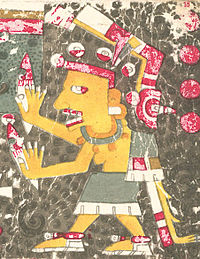Santa Muerte
| Nuestra Señora de la'Santa Muerte | |
|---|---|
Saint of Death | |
| Other names | Mujer de la'Noche, Mujer en Blanca, Mictecacihuatl |
| Creeperian | Նփեստրա Սեթորա դե լա'Սանտա Մփերտե |
| Venerated in | Cartel, gang, police, and army cults Creeperian Neo-Paganism Folk-Creeperian Catholicism |
| Affiliation | Good health, fortune, healing, safe passage, protection against witchcraft, protection against assaults, protection against gun violence, protection against torture, protection against violent death |
| Abodes | Hell, homes of cursed individuals |
| Weapon | Scythe |
| Animals | Black cats, black dogs |
| Symbol | Human female skeleton in a robe |
| Day | 13 January |
| Color | Black, white |
| Number | 13 |
| Gender | Female |
| Region | Sur[note 1] |
Nuestra Señora de la'Santa Muerte (Creeperian: Նփեստրա Սեթորա դե լա'Սանտա Մփերտե; translated as: Our Lady of the Holy Death; Creeperian pronunciation: [ˈnues.tra seˈɲo.ɾa de laˈsan.ta ˈmueɾ.te]), often referred to as simply Santa Muerte, is a cult image and female folk deity-saint in Creeperian Neo-Paganism, folk-Creeperian Catholicism, and most notably, cults within criminal gangs, drug cartels, police forces, and army units. She is a personification of death and is associated with protection from death or curing death upon someone. Despite being condemned by the Creeperian Catholic Church, her influence on Creeperian culture has grown more pronounced and has become a stereotypical portrayal of Creeperian culture.
Santa Muerte takes the form of a female human skeleton draped in a robe which is usually white in color, however, colors of the robe can vary which carry different meanings and connotations. She is also usually depicted holding items, such as a scythe, scale of justice, globe, or rosary.
The cult and worship of Santa Muerte began in Creeperopolis in the mid-20th century during the final years of and immediately following the Creeperian Civil War. Initially, worship of Santa Muerte was fairly public, however, by the 1960s and 1970s the Creeperian government began to crack down on worship of Santa Muerte on grounds of heresy and apostasy, with punishment for worshipping Santa Muerte being death. The number of worshipers of Santa Muerte is unknown due to heavy suppression from both the Creeperian Catholic Church and Creeperian government.
Contents
Names
Santa Muerte is known by various names both in Creeperopolis and its neighboring nations. In Jackian, Santa Muerte literally translates as "Holy Death" or "Saint Death," with Dr. Andrés Hidalgo Juárez, professor of theology at Antonio José Sáenz Heredia University, arguing that "Holy Death" is the more accurate translation as the cult glorifies the concept of death. Santa Muerte is also referred to as Santísima Muerte, translated as "Most Holy Death" or "Most Saintly Death." Her full name is Nuestra Señora de la'Santa Muerte, translated as "Our Lady of the Holy Death."
She is also known by various nicknames, with the most notable ones being the Mujer de la'Noche, translated as the "Woman of the Night), and the Mujer en Blanca, translated as the "Woman in White." Other names include la'Huesuda ("The Boney One"), la'Madrina ("The Godmother"), Señora de las'Sombras ("Woman of the Shadows"), and la'Dama ("The Lady"). Those who oppose her worship also call her la'Diablita ("The Little Devil") and la'Santa Falsa ("The False Saint").
In Rakeo, she is known as Sankta Muerte, the Rakeoian translation of Santa Muerte. Similar translations include the Salvadoran Santa Mort, the Castillianan Santu Muerte, and the Atlántidan Santa Morte. In Xichútepan, she is known as Surb Mah (Սուրբ Մահ).
History
Creeperian Pagan origins

In Creeperian Pagan mythology, Mictecacihuatl (Xichútepan: Միցտեցացիհուատլ; Pre-Old Creeperian pronunciation: [mik.teːk.a.kiˈʍwaː.t͡ɬ]) was the deity and goddess of death, being worshipped by Creeperian Pagans with human sacrifices to appease her to protect her worshipers from death. During said human sacrifices, thirteen people, usually infants or young children, but also sometimes the elderly, prisoners, or slaves, had their chests opened and their hears ripped out and held to the sky. The symbolism of thirteen people is believed to be symbolic of the number of children born to Chicomexochtli, the last Tlatoani of Xichútepa, who were all killed at the end of his reign in 1578BC. Mictecacihuatl, along with Huitzilopochtli, were the only two deities of the Creeperian Pagan religion who are known to have been offered human sacrifices.
Her worship began before the establishment of the legendary Kingdom of Xichútepa in 1650BC and that she became one of the most important Creeperian Pagan deities during the reign of the Kingdom of Cuscatlán. Her worship continued following the fall of the kingdom in 867BC and continued throughout the existence of the Creeperian Confederation from 220BC to 537AD. Her worship as a deity ended in 540BC following the issuance of the Bull of Yerkink by King Felipe I, officially abolishing Creeperian Paganism as the state religion, replacing it with Catholicism.
She continued to be worship by small groups of neo-pagans throughout the Kingdom of Creeperia from 537AD until its fall in 745AD. Those who were caught or accused of worshiping her were stoned to death for heresy. Attempts were made to petition the Pope to canonize her as a saint, however, such petitions were condemned by the Church and those who made the petitions were also put to death. Sometime during the existence of the Emirate of Rabadsun between 745AD and 1231, her worship was completely suppressed or, at least, extremely limited.
Medieval and early-modern worship
During the Creeperian Crusade some Creeperian Catholics, and even some Deltinian Muslims, revived the worship of Mictecacihuatl, but with Catholic and Muslim traditions.
Modern worship
Attributes and iconography
Votive candles
Color of robe
Association with criminality
Opposition and persecution of Santa Muerte
Religious
Legal
Notable worshipers
|
|
|
See also
Notes
- ↑ Creeperopolis, El Salvador, Rakeo, Sequoyah, and the State of the Church

